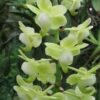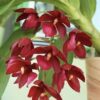# Adjusting Light Conditions for Quế Lan Hương Orchids Indoors

Quế Lan Hương orchids, known scientifically as *Dendrobium anosmum*, are celebrated for their stunning blooms and delightful fragrance. These orchids thrive under specific light conditions, making it essential for indoor growers to understand how to adjust and manage light exposure effectively. This comprehensive guide covers everything you need to know about providing the right light conditions for Quế Lan Hương orchids in an indoor environment, ensuring they flourish beautifully and healthily.
## 1. Understanding Quế Lan Hương Orchids
Before delving into light management, it’s crucial to understand the unique characteristics of Quế Lan Hương orchids:
– **Native Habitat**: Quế Lan Hương orchids are native to tropical regions of Southeast Asia, particularly Vietnam, where they grow in the understory of forests, receiving filtered sunlight.
– **Growth Habits**: These orchids are epiphytic, meaning they naturally grow on other plants or trees without harming them. They typically thrive in humid environments with good airflow and indirect light.
– **Flowering Characteristics**: Quế Lan Hương orchids produce stunning flowers that can last for several weeks, but their flowering can be influenced significantly by light exposure.
Understanding these aspects helps you replicate their natural conditions as closely as possible when growing them indoors.
## 2. The Importance of Light for Quế Lan Hương Orchids
Light plays a critical role in the growth and development of Quế Lan Hương orchids. Here’s why proper light conditions are vital:
– **Photosynthesis**: Like all plants, orchids use light to perform photosynthesis, a process that converts light energy into chemical energy, allowing them to grow and thrive.
– **Flowering Induction**: Sufficient light exposure is essential for inducing flowering in orchids. Insufficient light can result in poor bloom quality or a lack of flowers altogether.
– **Overall Health**: Proper light conditions contribute to the overall health of the plant, affecting its resilience against pests and diseases.
By adjusting light exposure according to the specific needs of Quế Lan Hương orchids, you can ensure vibrant growth and abundant blooms.
## 3. Ideal Light Conditions for Quế Lan Hương Orchids
### 3.1 Light Intensity
Quế Lan Hương orchids prefer bright, indirect light. Direct sunlight can scorch their leaves, while too little light can stunt growth. Here are guidelines for light intensity:
– **Ideal Range**: Aim for a light intensity of 1,500 to 3,000 foot-candles. This range mimics their natural environment, allowing for healthy growth and blooming.
– **Use of Light Meters**: Consider using a light meter to measure the light intensity in your growing area. This tool can help you determine if your orchids are receiving adequate light.
### 3.2 Duration of Light Exposure
The duration of light exposure is equally important for Quế Lan Hương orchids.
– **Daily Light Requirements**: Orchids generally require about 12 to 14 hours of light per day. This duration helps ensure they receive enough energy for photosynthesis and blooming.
– **Seasonal Adjustments**: Be aware of seasonal changes. During winter months, when natural light is less intense, you may need to supplement with artificial light to meet their needs.
## 4. Best Practices for Adjusting Light Conditions Indoors
Adjusting light conditions for Quế Lan Hương orchids indoors involves careful planning and implementation. Here are some best practices:
### 4.1 Choosing the Right Location
Selecting the right spot for your orchids is crucial:
– **Bright Windows**: Place your orchids near east or west-facing windows where they can receive bright, indirect light. Avoid south-facing windows that expose them to harsh direct sunlight.
– **Filtered Light**: If you only have south-facing windows, consider using sheer curtains to filter the light and prevent leaf burn.
### 4.2 Using Artificial Lighting
In situations where natural light is insufficient, especially during the winter months, artificial lighting can be a beneficial alternative:
– **Types of Lights**: LED grow lights are an excellent choice for orchids as they provide the right spectrum of light while remaining energy-efficient. Fluorescent lights are another option, although they may need to be positioned closer to the plants.
– **Light Positioning**: Position artificial lights about 12 to 18 inches above the orchids, adjusting as necessary to avoid leaf burn or insufficient light.
– **Timer Use**: Utilize timers to ensure that your orchids receive consistent light exposure for the recommended duration of 12 to 14 hours a day.
### 4.3 Monitoring and Adjusting Light Exposure
Monitoring your orchids’ response to light conditions is crucial for their health:
– **Observe Plant Behavior**: Watch for signs of insufficient or excessive light. Yellowing leaves may indicate too much light, while leggy growth suggests insufficient light.
– **Rotate Your Orchids**: To ensure even growth, rotate your orchids periodically so that all sides receive adequate light.
## 5. Seasonal Considerations for Light Management
Different seasons bring varying light conditions, which can affect your Quế Lan Hương orchids. Here’s how to manage light throughout the year:
### 5.1 Spring and Summer
During the spring and summer months, natural light is abundant:
– **Maximize Exposure**: Take advantage of longer days by placing orchids in the brightest locations. Ensure they receive the necessary 12 to 14 hours of light.
– **Watch for Heat**: Be cautious of heat buildup, particularly near windows. Ensure good airflow to prevent overheating.
### 5.2 Fall and Winter
As the days shorten, you may need to adjust your light management:
– **Supplemental Lighting**: Introduce supplemental lighting to maintain the required light duration. LED grow lights can be particularly effective during this period.
– **Adjust Positioning**: As the sun’s angle changes, you may need to reposition your orchids to ensure they continue receiving adequate light.
## 6. Troubleshooting Common Light-Related Issues
Even with careful management, you may encounter issues related to light exposure. Here are some common problems and solutions:
### 6.1 Yellowing Leaves
Yellowing leaves can indicate several issues:
– **Too Much Light**: If the leaves are bleached or scorched, your orchids may be receiving too much direct sunlight. Move them to a shadier location or filter the light.
– **Nutrient Deficiency**: Yellowing may also suggest a nutrient deficiency. Ensure you are using a balanced orchid fertilizer.
### 6.2 Leggy Growth
Leggy growth, characterized by elongated stems with sparse leaves, often indicates insufficient light:
– **Increase Light Exposure**: Move the orchids to a brighter location or supplement with artificial light.
– **Rotate Regularly**: Ensure that all sides of the plant receive light by rotating them regularly.
## 7. Conclusion
Adjusting and managing light conditions for Quế Lan Hương orchids in an indoor setting is crucial for their growth, health, and blooming potential. By understanding their specific light requirements and implementing best practices for light management, you can create an ideal environment for these beautiful orchids.
Regular monitoring and adjustments throughout the seasons will help ensure that your Quế Lan Hương orchids thrive, providing you with vibrant blooms and a touch of tropical beauty in your home. Whether you are a seasoned orchid enthusiast or a newcomer to orchid care, mastering light conditions will enhance your gardening experience and contribute to the success of your Quế Lan Hương orchids.

